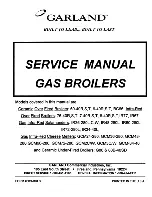
3-3
STARTUP AND COMMISSIONING
SL 26-260 G3, SL 40-399 G3 MODULATING GAS BOILERS
1.
Turn off the gas supply. With a small (1/8” or 3 mm) flat screwdriver, open the inlet gas
supply pressure test port by turning its center-screw one full turn counterclockwise.
Attach a manometer to the pressure test port, and turn on the gas to the appliance.
The static manometer reading should be ideally 7” w.c. for Natural Gas and 11” w.c. for
Propane. Minimum and maximum static pressure should be between 4” and 14” w.c.
Monitor pressure throughout the commissioning procedure. Pressure may drop up to 1”
to 2” w.c. at high fire but under no circumstances should it drop below 4” w.c. at the gas
valve inlet test port.
2.
Allow the boiler to ignite. Run against a large load, to maintain high fire.
3.
With a combustion analyzer probe in the flue gas test port, turn the High Fire (Gas:Air
Ratio) Adjustment screw (see Figure 37A and Figure 37B) (see Table 7 below for the
corresponding CO
2
values - set the CO
2
target at high fire). This screw offers very fine
adjustment, and may require several turns.
NOTE:
This screw has significant backlash. When changing direction of turn, it may
take up to a full turn before any change is indicated on the analyzer reading. Clock
the gas meter to confirm full maximum rating plate input.
4.
Confirm the minimum fire level settings. Re-define the load as “Manual Control”.
Use Heat Output in “Configure Load x” to control the output as needed. The reading
should be within the Low fire range. Re-test at high fire.
5. Turn boiler off by removing the call for heat (use the Installer Setup screen to
turn load to off if no other ready means available). Turn off gas then remove the
manometer connections, and turn the centre-screw in the manifold pressure test port
clockwise until fully closed. Ensure fully closed, but not over-tightened. Restore gas
and soap test for leaks.
DANGER
Making adjustments to the IBC
gas valve without a properly
calibrated gas combustion
analyzer and by persons who
are not trained and experienced
in its use is forbidden. Failure to
use an analyzer can result in an
immediate hazard.
Table 7: Combustion test target ranges - CO
2
/ Maximum CO
MODEL
C
HIGH FIRE
LOW FIRE
CO MAX
PPM
RANGE
TARGET
RANGE
TARGET
Natural Gas
9.0 – 10.0
9.5
8.2 – 9.2
8.7
< 150
Propane
10.3 – 11.3
10.8
9.3 – 10.3
9.8
< 250
Note
: Low Fire
CO
2
should be at least 0.5% lower than High Fire
CO
2
















































